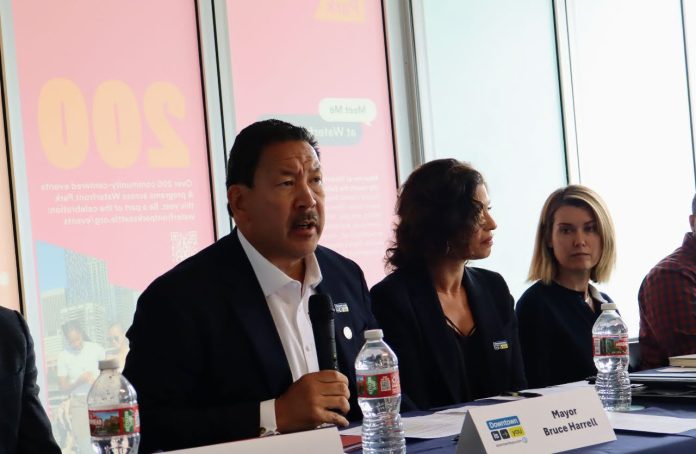
Bruce Harrell has a new line on the campaign trail, establishing himself as a champion of multimodal transportation and touting success reducing traffic fatalities in Seattle. But the lofty rhetoric, employed at several recent candidate forums in Fremont and Bitter Lake, obscures the full picture on the ground, with Harrell cherry-picking outdated data points to make his case.
Transportation has been far from one of the most prominent issues over the past few months, as Harrell finds himself in the fight of his political life against Transit Riders Union founder Katie Wilson, who beat Harrell in a surprise upset by nearly 10 points in the August primary. But the topic has been coming up more and more, as Harrell tries to point to successes that he’s been able notch since taking office in early 2022.
At a climate-focused forum at the Bitter Lake Community Center last week, hosted by Harrell-friendly orgs including Cascade Bicycle Club and Transportation Choices Coalition, he pointed to the $1.55 billion transportation levy voters approved last fall as just such a success.
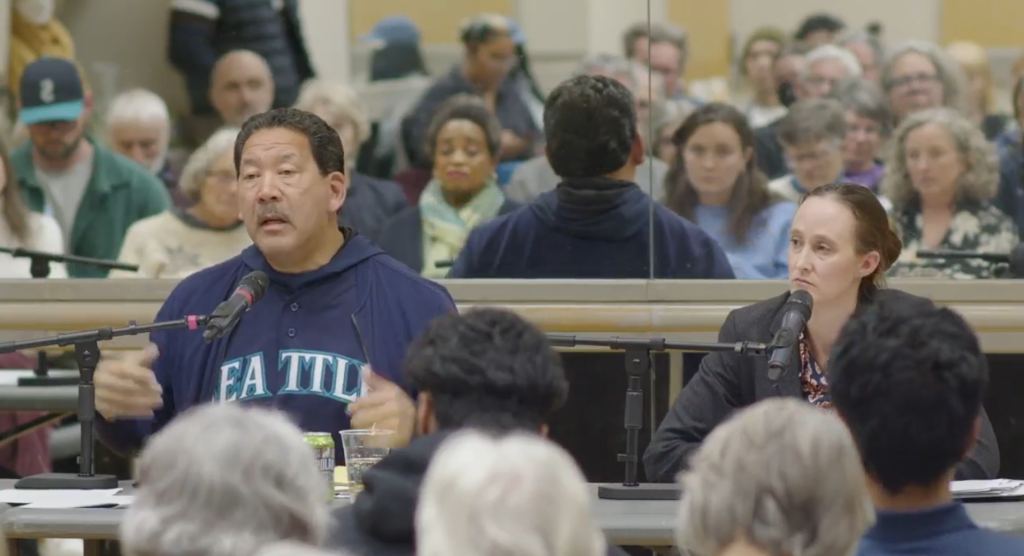
“When I inherited the job and I won the job, we still lived in a city by which cars are fighting with bikes and bikes are perhaps competing with transit, and people looked at the different forms of transportation and they didn’t talk to each other very well,” Harrell told the crowd. “And what I tried to do is change the conversation and negotiating a package of 1.55 billion, leading with safety first, and then reliability, and then connectivity was the package we put together.”
That levy, which is heavily weighted toward investments in road and bridge maintenance, was initially set at $1.35 billion but later revised upwards by Harrell’s office after transportation advocates pushed to go bolder, pointing at public polling showing support for a more transformative $1.7 billion. The added funding included more dollars for sidewalks, transit, and bike projects, though the only concrete goals (so to speak) were on sidewalks. The Seattle City Council added another $100 million in spending, but rejected an amendment to go further after the Seattle Metropolitan Chamber of Commerce balked.
“We put over $430 million for these types of safety mechanisms. We’re very proud that we had a drop in pedestrian deaths. Our death count was below 10. It was half of what it was in 2021. In 2024 we had no bicyclist deaths. And so we if we invest in the right way and we connect in the right way, lives are saved,” Harrell said, repeating a line he used the previous month at a Fremont Neighborhood Council forum.
Here’s the part Harrell got right: in 2024, initial data showed a significant decrease in the number of people killed while walking on Seattle’s streets, though the total was later revised upward to 11 fatalities, according to the Seattle Department of Transportation’s collision database. That was a big drop from 2021, a year where 20 people walking were killed.
With decreases three years in a row, the trend line appeared to be continuing to fall throughout Harrell’s term. But so far in 2025, 15 pedestrians have been killed in traffic crashes, with over two months left in the year. Overall pedestrian deaths remain much higher than they were a decade ago, when Seattle committed to eliminating all fatalities on city streets by 2030.
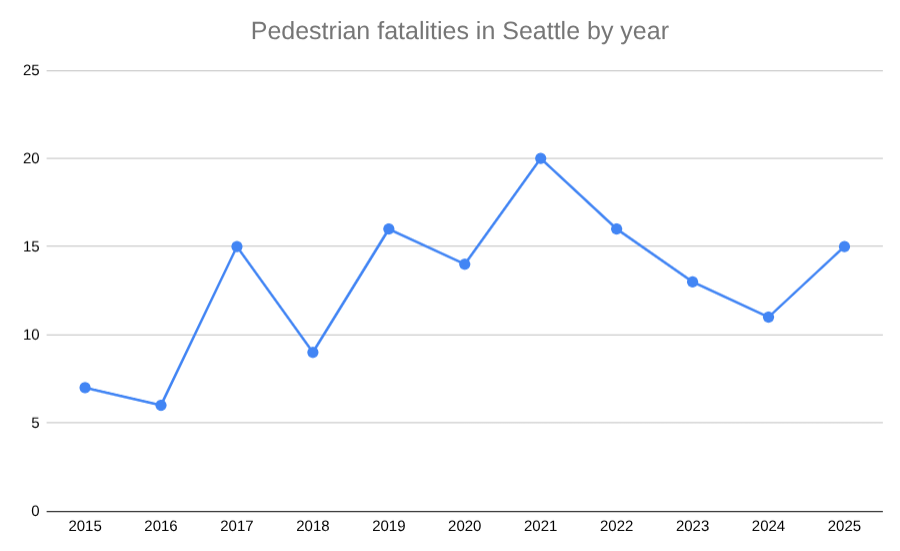
And while 2024 was a year of encouragingly low pedestrian fatalities on Seattle’s streets, it was the deadliest year overall on Seattle’s roads since 2006, with 32 people killed while driving cars or motorcycles, riding scooters, or walking. Among the lives lost last year was Chandler Gayton, who died while driving a motorcycle on Lake City Way on July 20, hitting a Honda minivan after reportedly going through a red light. Gayton had worked as a strategic advisor for public safety in Bruce Harrell’s office.
Compared to the four years of Harrell’s predecessor, Jenny Durkan, overall traffic fatalities in the city have actually increased by 13.5% since the start of 2022 with time left in the term. Over that time, there has been a 6.8% drop in pedestrian fatalities, a far cry from Harrell’s portrayal of them being cut in half.
The big question is: how do those numbers relate to the traffic safety strategies that have been employed under Harrell’s leadership?
His term has largely been marked by a continuation of initiatives that were started before he took office, as the Seattle Department of Transportation (SDOT) worked to finish a slate of “deliverables” approved by voters with the 2015 Move Seattle Levy that expired at the end of last year. Those included an ambitious mileage goal for new bike facilities, and a commitment to build Safe Routes to School upgrades at every single public school in the city.
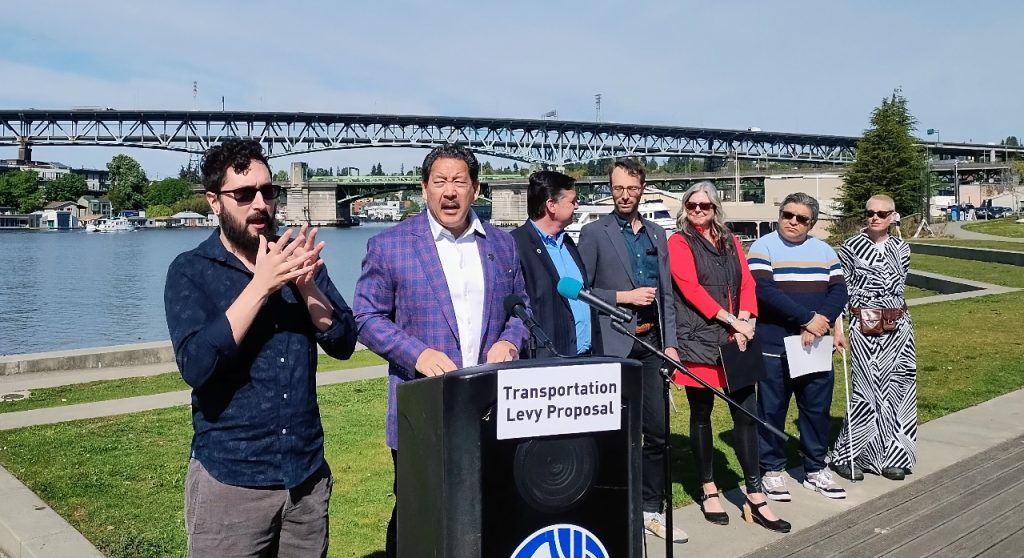
Harrell did tout one new initiative that started on his watch: a new SDOT policy to implement no-right-on-red restrictions along with any other major street upgrades, with the onus on the department to find a reasonable justification not to add signage. Announced in mid-2023, the idea to make this change came directly from the city’s Vision Zero team.
“When I directed our department to prohibit right turns all around the city, my email box was full because people don’t,” Harrell said, cutting himself off. “But we’re saving lives, and that’s how we’re going to have to do it. We have to adjust with the new forms of transportation. We have to look at the technology is changing, and we have to make sacrifices. And these are the decisions that an executive has to make. These are tough decisions, but they’re the right decisions, and that’s how we lead.”
When Harrell hired Greg Spotts, an assistant transportation director for the City of Los Angeles, to be his SDOT Director in mid-2022, Vision Zero was at the center of his transition into city government, coming right on the heels of that deadly 2021. Before being in office a full month, Spotts joined cyclists to mourn the loss of Robb Mason, who had been killed at the foot of the West Seattle swing bridge in July. At the event, Spotts told attendees that Vision Zero wasn’t going to live in a “pocket” of the organization any longer.
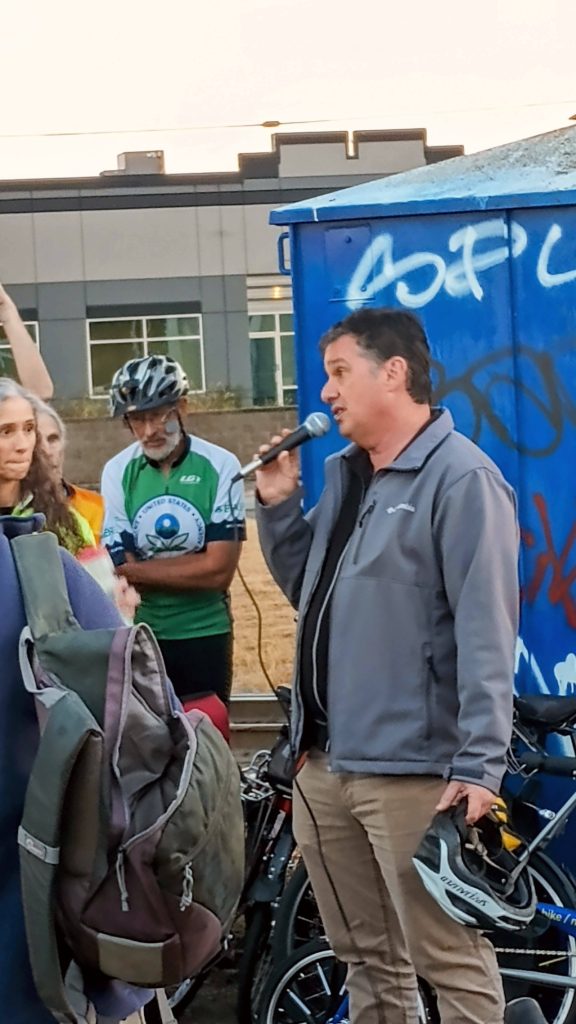
Spotts launched a 90-day “top to bottom review” of the Vision Zero program as one of his first major moves in the job, but that review was met with mixed reviews when it was released late in early 2023.
“The review, a 37-page report supplemented by a graphics-heavy 22-page ‘overview,’ includes exactly 100 recommendations—a nice round number that suggests padding,” PubliCola’s Erica C. Barnett wrote at the time. “And indeed, almost a quarter of the strategies the report suggests are things SDOT is already doing—for example, ‘[c]ontinue to clarify and measure desired outcomes of educational programs.’ Many others are vague to the point of abstraction.”
One of the most prominent actions to come out of the top-to-bottom review was the appointment of Venu Nemani, the city’s traffic engineer, to the new role as Chief Transportation Safety Officer, a move that signaled an elevation of the issue of safety up to SDOT’s top leadership group. But these days, Nemani is serving double-duty in both that role and as head of the Traffic Operations Division, suggesting safety isn’t important enough to have a dedicated point-person anymore.
When Spotts abruptly announced he would step down from the role of SDOT Director in early 2024, Harrell appointed Adiam Emery, who had been serving as one of his Deputy Mayors, as the interim pick to replace him. While Emery’s term so far has been marked by more butting of heads with transportation advocates — over projects like Aurora Avenue, Denny Way bus lanes, and a rushed attempt to remove a bus-only lane on E Union Street — there have been some through lines between the two directors. One of them is a major reluctance to tackle some of the city’s most dangerous streets and, as the Vision Zero report recommends, “be willing to reduce vehicle travel speeds and convenience to improve safety.”
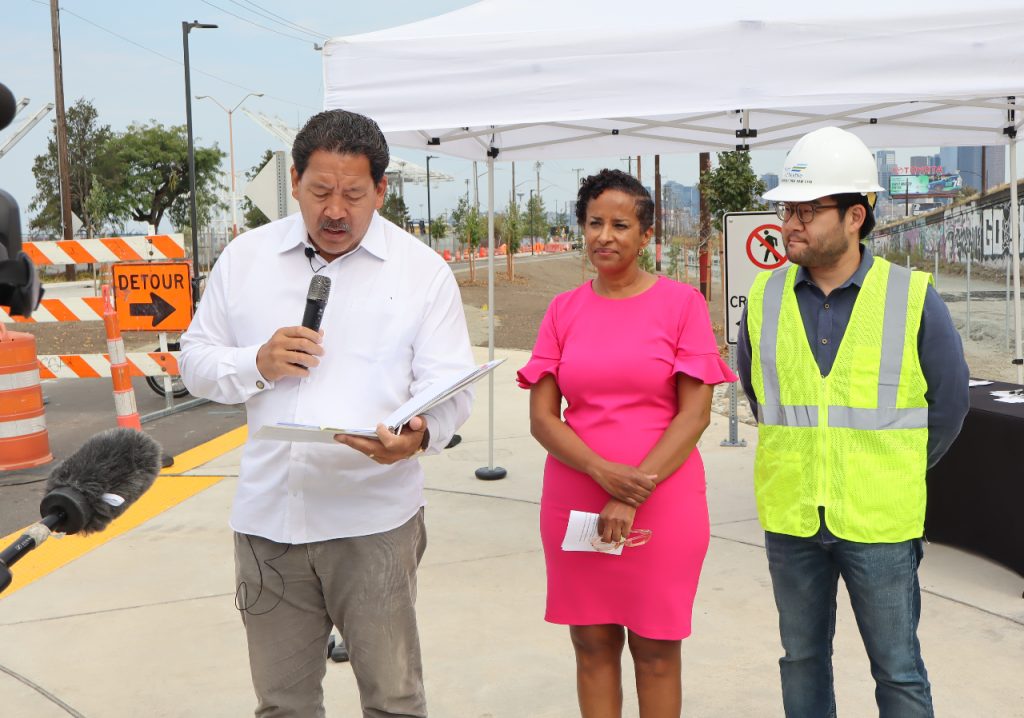
“The single most important thing the city can do is redesign dangerous streets,” the transportation advocacy group Seattle Neighborhood Greenways wrote in its own review of the Vision Zero program during those long 90 days. “Reducing the number of lanes and converting the extra space to widened sidewalks, protected bike lanes, bus lanes, or even planting strips for street trees is the most effective strategy. The West Seattle bridge repair project demonstrated that SDOT can still do big things, well, and quickly. SDOT can deliver on safe street projects with a similar proficiency if it has mayoral backing.”
While the new transportation levy includes a commitment to redesign 12 high-injury corridors over the next seven years, many of those projects remain in planning, with the full scope of those redesigns not yet known. The levy’s biggest tests lie ahead, including the question of whether the city will finally get bold enough to implement the type of changes needed to make streets like Rainier Avenue safer for everyone.
If Seattle does see an overall drop in traffic collisions in 2025, that will be part of a statewide trend. Initial data collected by the Washington Traffic Safety Commission showed a 25% drop in total traffic fatalities through September, with 450 lives lost over those nine months compared to 604 in 2024.
In Seattle, the campaign rhetoric doesn’t align up so easily with the actual results. Harrell’s true legacy when it comes to making the city streets safer may not be known for years.
Ryan Packer has been writing for The Urbanist since 2015, and currently reports full-time as Contributing Editor. Their beats are transportation, land use, public space, traffic safety, and obscure community meetings. Packer has also reported for other regional outlets including BikePortland, Seattle Met, and PubliCola. They live in the Capitol Hill neighborhood of Seattle.

